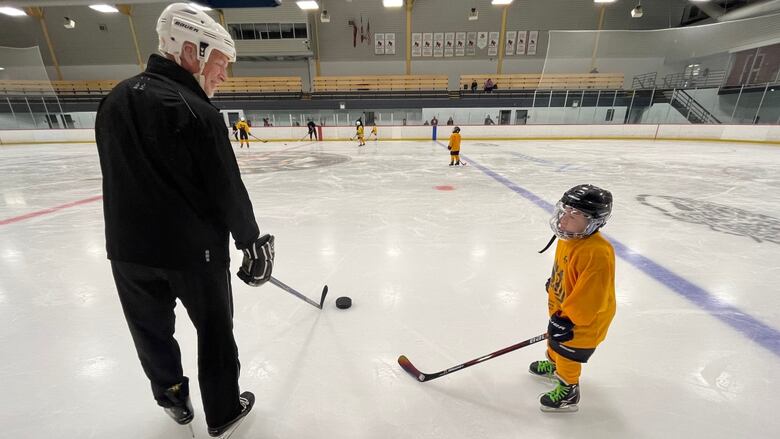This camp is teaching blind youth how to play hockey — and helping the sport grow internationally
Blind hockey development camp started in 2014 with a few players, now has 55 from multiple countries

Joe Fornasier thought his hockey days were over when, at just 10 years old, he lost 96 per cent of his vision in two months.
The aspiring young player was diagnosed with Leber hereditary optic neuropathy, a rare disorder causing vision failure, and told he would have to hang up his skates.
"It crushed me," he said. "Pretty much my whole world flipped upside down at that point."
But six years later, Fornasier became the youngest player ever to make the Canadian National Blind Hockey team.
The turning point, he tells CBC News Toronto, was when he enrolled in the Canadian Blind Hockey summer camp a few years after losing his sight.
"That same passion and fire that I had in regular hockey—it came back to me and I was able to play again," said Fornasier, despite there only being a handful of players there.
The camp is now celebrating its seventh year at the Iceland Arena in Mississauga and is now attracting youth, adult and elite players from across the country as the sport grows in popularity, organizers say.
Now 19 years old and a three-time gold-medallist with the national team, Fornasier says blind hockey is "light years ahead" of when he started playing and is giving blind and partially-sighted kids across Canada the chance to play the game.

A large part of what makes blind hockey possible is a hollow, adapted puck — three times the size of a regular hockey puck — which has eight ball-bearings rattling inside so players can hear it.
The game is also played with shorter nets. An attacking team must also pass at least once after crossing the offensive blue line before it can score.
The most notable difference is players must be legally blind, meaning they have no more than 10 percent of their vision, while goalies must be fully blind.
'The sky is the limit'
Canadian Blind Hockey executive director Matt Morrow says this year's camp will feature most of the national team, as well as some elite players trying to make the cut.
"Any time we host an event like this, it has the effect of growing the para sport of blind hockey," said Morrow, adding there are 55 participants this year, including players from Europe.
He says the camp not only helps develop the elite players, but gives them a chance to mentor youth players, some of whom are as young as six and lacing up for the first time.
"Once you get that adapted puck out there and you get them into program with other kids who are blind or partially sighted with the adapted rules, it just shows the sky is the limit," said Morrow.

Laura Mark, an operations coordinator with the Canadian National Institute for the Blind (CNIB), one of the camp's sponors, says tournaments like this help change the mindset about what can be achieved by the visually impaired.
"Just because you have a vision impairment doesn't mean you can't play sport," said Mark, herself a blind hockey player who helps coordinate the girls' and women's programs for Canadian Blind Hockey.
Many still don't know blind hockey exists
But, she says, the biggest barrier is still a lack of awareness of the game.
"There are so many people I meet walking down the street that don't know blind hockey exists," said Mark.
She says the camp gives blind children chance they wouldn't have in everyday life to meet other blind or partially-sighted youth.
"It's great to be able to play hockey with individuals who can relate to them on a daily basis because they too have vision loss."
But while there are more blind hockey programs in Canada than there have ever been, Mark says many players still have to travel great distances to participate.

Morrow says the problem is solved by simply continuing to build the sport through camps, tournaments and other events.
"One of our largest recruitments is word of mouth, where participants know other people who are blind or partially sighted," said Morrow.
Over 10 years ago, Morrow says blind hockey was an exclusively Canadian enterprise, but it is now played in the United States, England, Russia, Finland and Sweden.
More teams needed for Paralympic entry
"What we're seeing especially with the high performance division is the bar keeps getting raised for the competitive aspect of blind hockey," added Morrow.
He says COVID partially disrupted the sport's momentum, but Canadian Blind Hockey has resumed efforts to develop teams in other countries and ultimately hopes to get blind hockey into the Paralympics.
The U.S., he says, "now has a very robust blind hockey program," adding eight national teams are needed before the sport will be considered for the Paralympics.
He says clinics have started in Finland, Sweden, England and Japan.

For Fornasier, the camp is "bigger than hockey," and is an escape from reality for so many blind youth.
"I used to always sit and think, 'Why me?'" said Fornasier. "Now it's 'Why not me? Why can't I be the greatest blind hockey player in the world?'"

